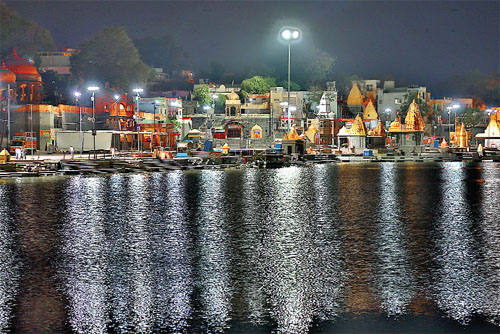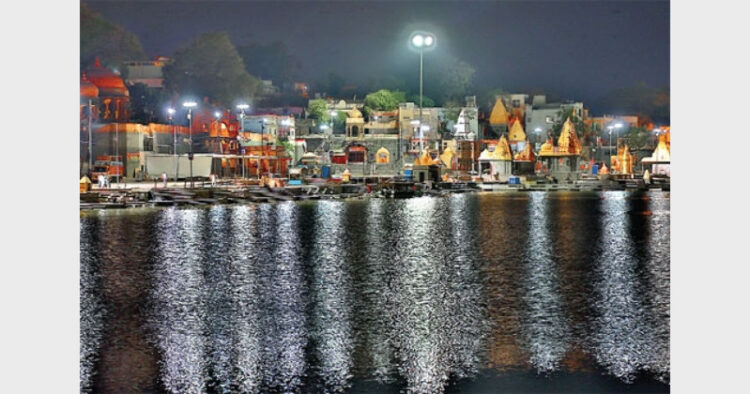Mahesh Sharma from Ujjain
 After twelve years, Ujjain is once again spruced up for the Simhastha Mahakumbh. The holy dip in Kshipra River begins with the Purnima of Chaitra and ends with the Vaishakh Purnima, i.e., from April 22 to May 21. During this period, it is estimated that about five crore devotees will visit Ujjain, and on the eve of Shahi Snan one crore pilgrims will be present on the auspicious occassion.
After twelve years, Ujjain is once again spruced up for the Simhastha Mahakumbh. The holy dip in Kshipra River begins with the Purnima of Chaitra and ends with the Vaishakh Purnima, i.e., from April 22 to May 21. During this period, it is estimated that about five crore devotees will visit Ujjain, and on the eve of Shahi Snan one crore pilgrims will be present on the auspicious occassion.
Akharas: The Historical Background With the start of royal procession of Akharas in Ujjain for Simhastha Mahakumbh, arrival of the saints in the city has started. |
The Government of Madhya Pradesh started making preparations in the year 2011 itself. People feel that the government has learnt lesson from the Simhastha 2004. The BJP Government that came into power in the year 2003 had to work hard in very short time for making preparations for 2004, because the earlier Digvijay Singh Government had done nothing. Making preparations four years back was certainly a welcome move. By doing so the BJP Government wished to ensure that all the arrangement would be done in time. Overcoming all the legal and other hurdles the works were completed within time. “We can say it with confidence today that the the arrangement would be on an expenditure of 3000 crore have been done with quality and sustainability”, says Diwakar Natu, the Officer Incharge of Simhastha Kumbh Mela.
Ten bridges have been constructed at a time, four are rail overbridges and six are on the Kshipra River. The cost of these bridges has been 186 crore. Additionally, a bye-pass of 14.29 kms has been constructed by investing Rs 94.3 crore. Two fly overs, one rail overbridge and one bridge across the holy Kshipra has also been built on the bye-pass. The construction of fourth arm of the three-armed Hari-Fatak bridge also cost 10.81 crore. This will be useful not only for reaching the Mela area but also for reaching the Mahakal Temple. There was a plan to construct a bridge parallel to the old Freeganj bridge but the legal battle consumed lot of time and thus could not start the construction due to paucity of time, even though the Supreme Court had resolved the legal hurdles. The Chief Minister Shivraj Singh has promised that this will be completed in any case after the Mela because people of Ujjain will benefit from it even afterwards. The Executive Engineer of PWD Bridge Section Shobha Khanna says that they have used latest engineering technology in construction of the bridges, especially the Badnagar bye-pass overbridge. Its junction in itself requires the budget of an overbridge.
The Parallel Kumbhs When the spiritual conglomeration of Simhastha Kumbh will begin on April 22, there will be three parallel Kumbhs on the sidelines of it. The three initiatives to provide intellectual, artistic and social content to the spiritual fest would attract different lot of people to the historic city of Ujjain. The intellectual Kumbh to be organised from May 12-14, will address the issues of agricultural traditions, Cottage Industry, Woman power and Save Daughter and Importance of cleanliness. This mega event will be held at Ninaura, 8 kms from Ujjain on Indore road. RSS Sarsanghachalak Shri Mohan Bhagwat will inaugurate the event while Prime Minister is expected to address the concluding session. |
In the Simhastha mela area Rs 378 crore have been spent on 100 roads including 4 four-lanes. Beautiful lights have been provided on the four-lanes and plantation has been done on the dividers. Even flower-pots have been put up here and there, giving a joyful experience to the travelers. The bye-pass made for Nagda Unhel from Indore road is extremely useful. This resulted into expansion of the Mela area, and easy access to it as also to Badnagar. The 90 km long Panch-koshi Road has also been upgraded by spending 63 Rs crore. Anticipating large crowds visiting this year, the administration decided to triple the capacity of Nandi Hall. All the temples including 84 Mahadev temples have been renovated.
Expecting large numbers of pilgrims, the administration made 3.5 kms new pucca ghats on the river Khipra River. About 4.5 kms old ghats have been renovated. Cleaning and whitewashing these ghats have given additional charm to the Khipra River. The Minister Incharge Bhupendra Singh says that the Mela administration has maintained the qualility in all the works done, even though the works had to be done within time. The result being, Ujjain has become one of the beautiful cities of the country. For the first time the Government made permanent constructions within the boundaries of all the ‘Akharas’. The Shivraj Singh government has been very keen on timely construction and its quality. The total cost of Simhastha Kumbh after spending money over the temporary works is likely to amount to Rs 5000. It is important to note that only Rs 262 were allocated for the Simhastha 2004 by the previous government, out of which Rs 93 crore were given to the construction of a seven-storeyed hospital of 450 beds and modern operation theatre. Unfortunately the hospital is not ready for use even today, and only doctors are staying in it.
The Great Kumbh Festival and Ocean Churning It is now countdown for the commencement of Simhastha Mahakumbh, and the spiritual fragrance has already started to dwell in and around Ujjain. The tradition of the great festivity of the Kumbh is associated with the legend of ocean churning (Samundra Manthan). It is said that out of the fourteen valuables which were found during the ocean churning, ‘nectar of immortality’ was one. There was a struggle between gods and demons to acquire the nectar for immortality, and amidst this scuffle, nectar slopped at four different pilgrimages making them sites for salvation. The nectar had fallen at Haridwar, Allahabad, Nasik and Ujjain, and hence forth, great festivity of Kumbh is organised here. |
The greatest challenge for the administration is to provide pure drinking water from Kshipra River that could also be used for worship and ‘achaman’. Polluted Khan river meets Kshipra and therefore a project has been launched to divert this river. This project costs Rs 85.62 crore. Under this project, 19.5 kms long pipeline is being laid below 12 metres of the ground. Since Kshipra does not flow all the 12 months of the year, the government has also made a project of linking Narmada with Kshipra. For this 49 kms pipelines have been laid and pumping stations have been put up for supplying water into Kshipra. This project has cost Rs 432 crore. Now water of Kshipra can be supplied in the city for drinking purpose also. Two water treatment plants of 7.75 million gallon have been installed at the cost of Rs 12 crore.
Today the Simhastha Kumbh spreading on an area of 3,000 hectare looks like a vast city in itself. The lightings are perfect but people express doubts about the seaverage system. Tight security arrangements have been made. About 650 CCTV cameras have been fixed in different places. About 51 temporary police stations have been set up. The police department has been allotted a budget of Rs 297 crore for this purpose. In addition to the central paramilitary forces, 25,000 police personnel are being deployed from within the state.
The government is so confident of its preparedness that they have made publicity even out of the country. A budget of Rs 58 crore has been earmarked for publicity overseas, which they are doing on airports, tickets, hoardings, stickers etc. Advertisements have been issued in the magazines given to air travelers.
All eyes are on the first Shahi Snan on April 22, when about one crore pilgrims will gather on the bank of Kshipra to assess whether governmental efforts have succeeded or failed.
(The writer is senior Journalist)













Comments